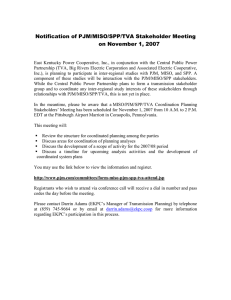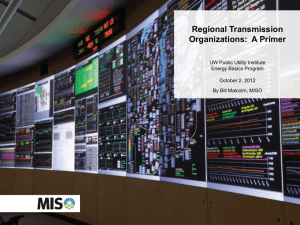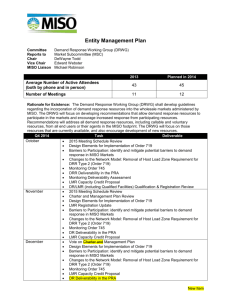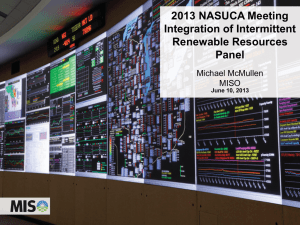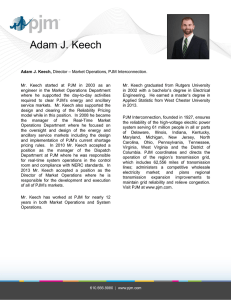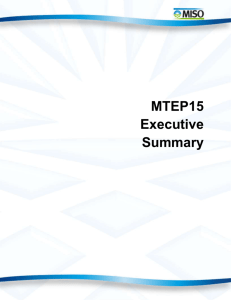What is Coordinated Interchange?
advertisement
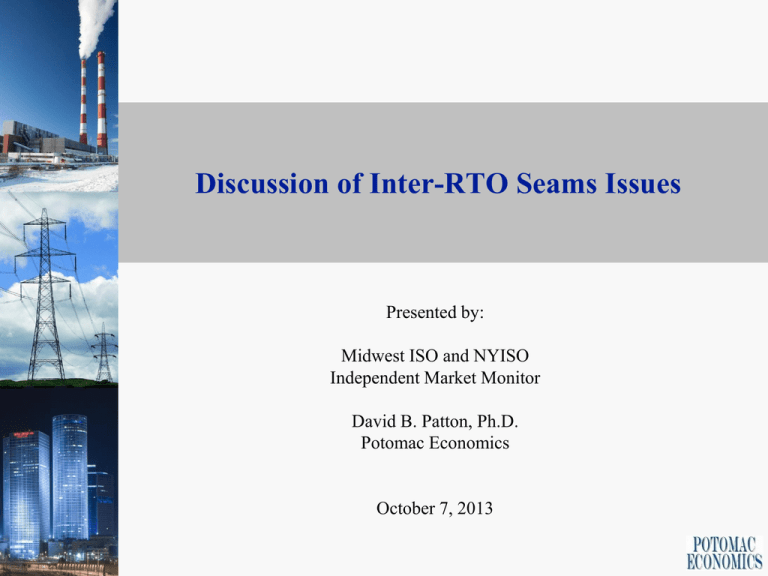
Discussion of Inter-RTO Seams Issues Presented by: Midwest ISO and NYISO Independent Market Monitor David B. Patton, Ph.D. Potomac Economics October 7, 2013 Introduction • The eastern interconnect is operated by a relatively small number of RTOs and utilities. Because power flows over the network governed primarily by the laws of physics, these markets and systems are heavily interdependent, giving rise to “seams issues”. • Substantial work has been done to address these seams issues: For example, market-to-market coordination between PJM and both MISO and NYISO plays a critical role in managing network congestion efficiently. • However, energy transactions between areas are still scheduled in relatively a relatively unsophisticated manner, contributing to significant inefficiencies. • In the presentation, I discuss two opportunities for improvement: Coordinated interchange; and Remedying a significant error in PJM and MISO’s current interface prices. The Need for Coordinated Interchange • The benefits of fully utilizing the interfaces between areas is intuitive. Differences in prices between the markets indicates the potential for savings as inter-regional trades allow lower cost resources in one area to displace higher-cost resources in the other area. Under the current markets, participants’ ability to capture these benefits by effectively arbitraging the price differences is undermined by: – They must submit transactions 30 minutes or more in advance of when the power will flow. – The lack of coordination among participants, which leads to substantial errors in the aggregate quantities of transactions. • These barriers to efficient trading also cause the RTO’s to commit more resources for reliability because they cannot trust that the interchange will adjust as needed if conditions become tight – raising uplift in all RTO areas. • Current scheduling practices are not efficient – the interregional price differences are typically larger than $10 per MWh. -3- The Need for Coordinated Interchange • • Inefficiencies occur in almost all hours, but the economic and reliability impacts of poor interchange can be extremely large during tight conditions. A good example of this occurred on July 6, 2012 in MISO: In early afternoon, net imports from PJM fell more than 1,500 MW because prices when the transactions were scheduled (30-45 minutes early) were higher in PJM than in MISO. – This drop in net imports was the single most significant factor that drove MISO into to a deep reserve shortage and caused energy prices to rise to $2400 per MWh. MISO committed more than 1.5 GW for reliability. The price spike in MISO led to a sharp 3 GW swing in net imports back into MISO from PJM. – This swing in net imports caused prices in MISO to collapse and resulted in MISO making large uplift payments to resources committed for reliability. Later in the afternoon, this cycle repeated and MISO experienced another reserve shortage and prices peaking at $1500 per MWh. • These shortages in July raised average prices by almost 20 percent for the month. -4- What is Coordinated Interchange? • Coordinated interchange can be accomplished in a number of ways. The most popular proposal is to allow intra-hour transactions that would be scheduled for a 5 or 15 minute period when the RTO’s forecast a price difference larger than the participant’s offer price. • This proposal and others that have been discussed would capture similar benefits because they would all: Eliminate the current scheduling lag of 30 minutes to 1 hour; Coordinate the quantity of the interchange adjustments to eliminate the overreactions and under-reactions to the price differences. • PJM has talked about implementing such improvements on both its seam with New York ISO and MISO, but it is not a high priority with the stakeholders. -5- Benefits of Coordinated Interchange • • A few years ago, we estimated the efficiency savings of coordinating interchange at these interfaces and others around Lake Erie. In total, we found $116 million in production cost savings from optimizing the interchange over the NYISO and MISO interfaces with PJM. These benefits are evenly divided between the two interfaces. We believe these values to be understated because the study period of November 2008 to October 2009 was a period of low load and fuel prices, which decreases the economic savings of optimizing the interchange. • Importantly, the short-term impacts on prices tend to be much larger than production cost savings. In the last study, we found that the savings for consumers were 5 times larger than the production cost savings. • Based on these savings and the reduced need to commit resources for reliability (and associated uplift costs), we believe coordinated interchange should be a high priority. -6- Interface Pricing Error • • We continue to be very concerned that MISO and PJM’s interface prices contain a substantial error when a market-to-market constraint is binding. The error arises when a M2M constraint is binding in both the MISO and PJM markets. In this case, when a transaction is scheduled that involves both RTOs, the transaction will be over-paid or over-charged because it settles with both RTOs. • The non-monitoring RTO has no funding source for these payments, so these costs will ultimately be uplifted to the non-monitoring RTO’s customers as: • • The problem is that the payment by the monitoring RTO fully and efficiently compensates the transaction for the flow relief it provides. Therefore, every dollar paid by the non-monitoring RTO for the same relief is redundant with the payment made by the monitoring RTO. There is no justification for the non-monitoring RTO to make an additional payment or impose an additional charge on the transaction. Negative excess congestion fund (ECF) in MISO, balancing congestion in PJM, or FTR underfunding (MISO and PJM). We estimated that this resulted in inflated payments by PJM exceeding $33 million, which only includes MISO constraints and no other external constraints. The larger costs of this error are inefficient distortion of the dispatch it causes when transactions are scheduled inefficiently. -7-
